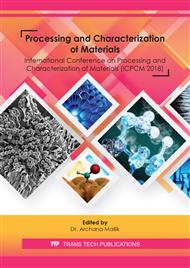[1]
A. Attanasio, F. Faini, J.C. Outeiro, FEM Simulation of Tool Wear in Drilling, Procedia CIRP. 58 (2017) 440–444.
DOI: 10.1016/j.procir.2017.03.249
Google Scholar
[2]
N. Feito, J. Díaz-Álvarez, J. López-Puente, M.H. Miguelez, Experimental and numerical analysis of step drill bit performance when drilling woven CFRPs, Compos. Struct. 184 (2018) 1147–1155.
DOI: 10.1016/j.compstruct.2017.10.061
Google Scholar
[3]
M. Hasan, J. Zhao, Z. Jiang, A review of modern advancements in micro drilling techniques, J. Manuf. Process. 29 (2017) 343–375.
Google Scholar
[4]
H.P. Tirtha Prasada . K Prakash Marimuthu, CS Chethan Kumar, 2D Finite Element Thermo-Mechanical Model to Predict Machining Induced Residual stresses using ALE Approach, Mater. Today Proc. 5 (2018).
DOI: 10.1016/j.matpr.2018.02.147
Google Scholar
[5]
S. Kaytbay, M. El-Hadek, Wear resistance and fracture mechanics of WC–Co composites, Int. J. Mater. Res. 105 (2014) 557–565.
DOI: 10.3139/146.111069
Google Scholar
[6]
A.R. Kohandehghan, S. Serajzadeh, Effect of welding sequence on residual stress distributions in GTA welding of AA5251 plate, Int. J. Mater. Res. 103 (2012) 371–377.
DOI: 10.3139/146.110605
Google Scholar
[7]
A. Laamouri, H. Sidhom, C. Braham, Evaluation of residual stress relaxation and its effect on fatigue strength of AISI 316L stainless steel ground surfaces: Experimental and numerical approaches, Int. J. Fatigue. 48 (2013) 109–121.
DOI: 10.1016/j.ijfatigue.2012.10.008
Google Scholar
[8]
A. Madariaga, P.J. Arrazola, I. Perez, R. Sanchez, J.J. Ruiz, F.J. Rubio, Reduction of Distortion of Large Aluminium Parts By Controlling Machining-Induced Residual Stresses, (2017) 1–15.
DOI: 10.1007/s00170-018-1965-2
Google Scholar
[9]
T. Matsumura, S. Tamura, Cutting Simulation of Titanium Alloy Drilling with Energy Analysis and FEM, Procedia CIRP. 31 (2015) 252–257.
DOI: 10.1016/j.procir.2015.03.045
Google Scholar
[10]
A.K. Parida, Simulation and experimental investigation of drilling of Ti-6Al-4V alloy, Int. J. Light. Mater. Manuf. 1 (2018) 197–205.
Google Scholar
[11]
J. Preußner, S. Oeser, W. Pfeiffer, A. Temmler, E. Willenborg, Microstructure and residual stresses of laser remelted surfaces of a hot work tool steel, Int. J. Mater. Res. 105 (2014) 328–336.
DOI: 10.3139/146.111027
Google Scholar
[12]
G. Ramya Devi, K. Palanikumar, Analysis on drilling of woven glass fibre reinforced aluminium sandwich laminates, J. Mater. Res. Technol. (2018).
DOI: 10.1016/j.jmrt.2018.06.021
Google Scholar
[13]
C. Zhao, Y. Huang, Z. Chen, S.K. Ha, Progressive failure prediction of a landing gear structure of braided composites, Compos. Struct. 161 (2017) 407–418.
DOI: 10.1016/j.compstruct.2016.11.076
Google Scholar
[14]
M. Zimmermann, V. Schulze, J. Hoffmeister, Finite element modelling of coverage effects during shot peening of IN718, Int. J. Mater. Res. 101 (2010) 951–962.
DOI: 10.3139/146.110375
Google Scholar


